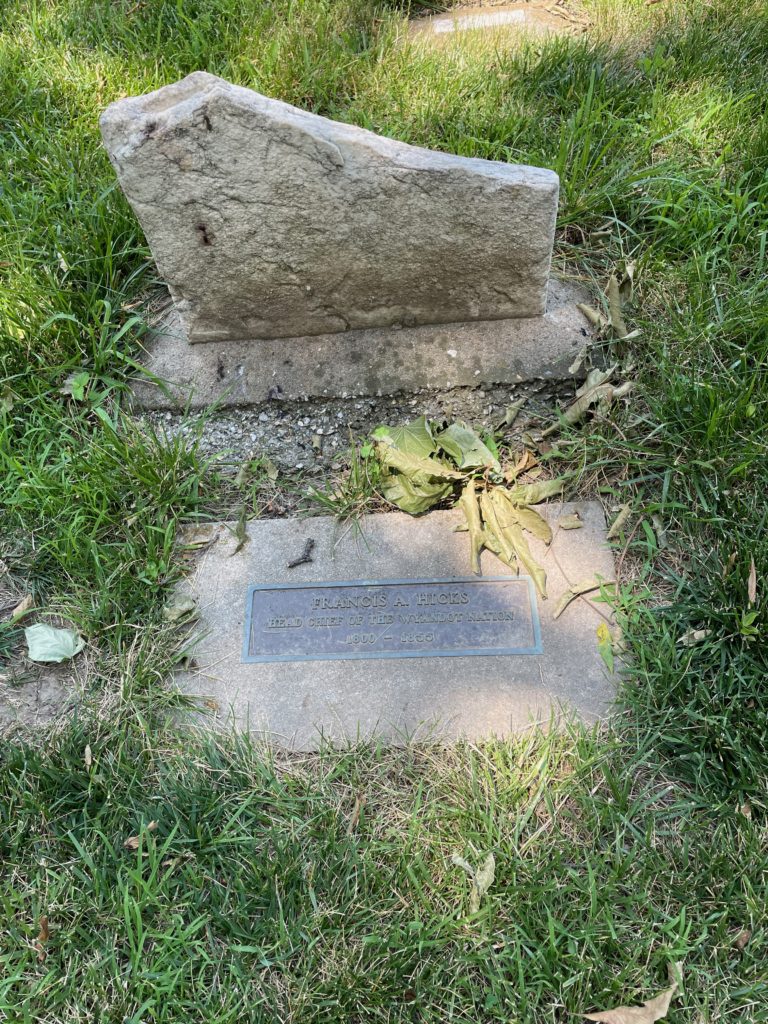Erik Visits an American Grave, Part 928
This is the grave of Francis Hicks.

I don’t know a lot of details about Francis Hicks. He was Wyandot, born around 1800, and he only comes up in the historical record (at least the relatively accessible historical record; I make no claims on what some historian might find in the archives) later in his life, when he had become a Wyandot leader and was trying to deal with the overwhelming explosion of the white population and the mass death that resulted from all it. By the 1830s, the tribes having any meaningful land in Ohio and Michigan was just untenable. White settlers were basically stealing the land anyway. Whites wanted to pay them more money in yearly annuities, guaranteed in an 1831 treaty. But they knew that other tribes, such as the Seneca and Shawnee, had accepted similar agreements and it was a disaster for them.
But conditions on the Wyandot reservation were getting worse all the time. Maybe 400 whites in various ways had moved to the reservation lands. Lots of them were squatters but it’s not as if the military was going to force them out. A lot of these people were real scumbags too. The kind of person who would move to a reservation and just steal the land was also quite likely more than happy to resort to violence. So there were a lot of problems. For one, Chief Summondowot and his family were murdered and no whites cared enough to find the killers, even though they knew them by name.
So on March 17, 1842, Francis Hicks, who was Principal Chief of the Wyandot, and six other chiefs, felt they had no choice but to sign away all Wyandot lands in Ohio and Michigan. They would join Wyandots at another reservation at Upper Sandusky and then all would be granted 148,000 acres somewhere west of the Mississippi River. Now, a word about Indian Removal. We all know the horrors of this whole process, primarily the Cherokee story. But what is not taught often enough is that it’s not as if this was empty land. There were already tribes in these areas. This was their homeland that whites were moving other peoples. They weren’t wanted. Sometimes, they were enemies of the resident tribes, more commonly they came from too far away to have had too many interactions with the local peoples. But conflict rose immediately, as more people competed for fewer resources, not to mention the many ways whites impacted all of this, whether through moving west or creating a market economy to incentivize the killing of deer and beaver and other animals. So a move to the west was not going to be a relief to the problems that faced the Wyandot.
The Wyandots started west in July 1843, when they went to Cincinnati, expecting to go by steamboat to St. Louis. The whole way they were gawked at and harassed by whites. People started dying immediately, whether of disease or a broken heart. Moreover, even as they had headed west, the government hadn’t even decided where they would go. The Wyandots had sent a party ahead to make a deal with the Delaware (the ultimate of removed tribes, again and again) to pay them for some land. But the government hadn’t gotten around to actually approving the deal. They ended up in the lands across the Missouri River from the small settlement of Kansas City, most certainly not far enough away from whites to solve any problems, as if that was even possible anyway.
Hicks died on the Wyandot lands outside of Kansas City in 1855.
Francis Hicks is buried at the Wyandot Burying Ground, Kansas City, Kansas. Unfortunately, this seems to be primarily a place today for homeless encampments and heroin usage, or at least it was when I was there.
For more on Indian Removal in the North, including most of what I could glean about Hicks, see John Bowes, Land to Good for Indians: Northern Indian Removal.
If you would like this series to visit more 19th century Native leaders, you can donate to cover the required expenses here. Red Cloud is in Pine Ridge, South Dakota and Black Hawk is in Burlington, Iowa. Previous posts in this series are archived here.


